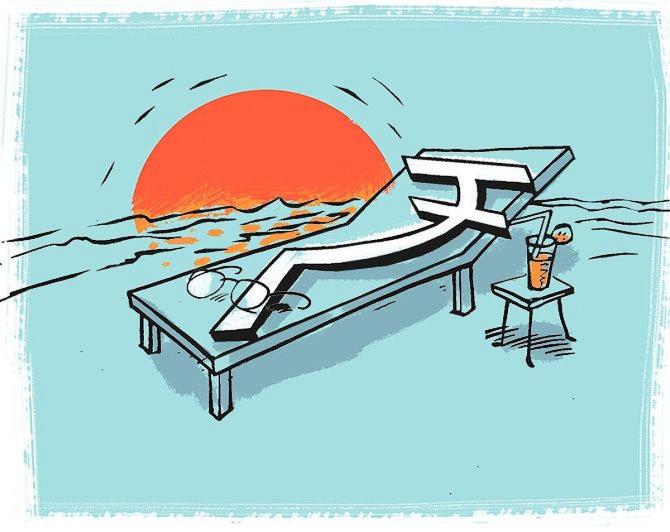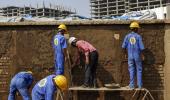India recorded GDP growth of 7.8 per cent during the April-June period of 2023-24, the highest in the past four quarters, on the back of double-digit expansion in the services sector, retaining its position as the world's fastest-growing major economy.

The Gross Domestic Product (GDP) recorded a growth of 13.1 per cent in the first quarter (Q1) of 2022-23, 6.2 per cent in the second, 4.5 per cent in the third and 6.1 per cent in the last quarter.
India's 7.8 per cent GDP growth in the April-June quarter is higher than the 6.3 per cent recorded by China during the same period.
According to the National Statistical Office (NSO) data released on Thursday, the agriculture sector gross value added (GVA) recorded a growth of 3.5 per cent up from 2.4 per cent in the April-June quarter of 2022-23.
The expansion in 'financial, real estate and professional services' GVA was 12.2 per cent, up from 8.5 per cent in the year-ago quarter.
A growth of 9.2 per cent has been witnessed by 'trade, hotel, transport, communication and services related to broadcasting sector', though lower than 25.7 per cent expansion in the year-ago quarter.
The manufacturing sector GVA too decelerated to 4.7 per cent in the first quarter of the current fiscal compared to 6.1 per cent in the year-ago period.

"Real GDP or GDP at constant (2011-12) prices in Q1 2023-24 is estimated to attain a level of Rs 40.37 lakh crore, as against Rs 37.44 lakh crore in Q1 2022-23, showing a growth of 7.8 per cent as compared to 13.1 per cent in Q1 2022-23," NSO said in a statement.
It further said the nominal GDP or GDP at current prices in the first quarter of 2023-24 has been estimated at Rs 70.67 lakh crore, as against Rs 65.42 lakh crore in the year-ago period, showing a growth of 8 per cent as compared to 27.7 per cent in Q1 2022-23.
Commenting on the GDP data, Aditi Nayar, Chief Economist, ICRA Ltd said 'private final consumption expenditure (PFCE)' growth witnessed an uptick to 6 per cent in Q1 FY2023 after a subdued performance in H2 FY2023.
Moreover, gross fixed capital formation (GFCF) grew at a robust pace of 8 per cent, notwithstanding the deceleration vis-à-vis the last quarter of FY2023, with the GFCF to GDP ratio (in nominal terms) rising to 29.3 per cent in Q1 FY2024 from 29.1 per cent in the year-ago period.
Assocham secretary General Deepak Sood said real GDP growth of 7.8 per cent in the first quarter of 2023-24 would certainly make major economies of the world envy of India which has become a major force in driving the global economy.
"At a time when major economies are grappling with high inflation, tight monetary conditions, supply disruptions amidst geo-political issues, India has navigated the global headwinds with courage, tenacity and a strong-willed political leadership," he said.
Puneet Kaura, MD and CEO, Samtel Avionics Limited and chairman, CII Delhi State Council, opined that the robust performance of the economy in the first quarter of the current financial year is on account of the performance of the services and agriculture sectors.
The government, he said should focus on the MSME sector to ensure sustained growth in the coming quarters and years as a vibrant MSME sector is also essential for boosting the country's exports and generating employment at large scale.
The NSO will release quarterly GDP estimates for the July-September quarter, 2023 (Q2 2023-24) will be on November 30, 2023.
Suvodeep Rakshit, senior economist at Kotak Institutional Equities, said investment growth continued to outpace consumption growth.
"We expect this trend to continue over the next couple of quarters.
“GDP growth prints will be lower than the 1Q print for the rest of the year.
“Going forward, we need to watch for risks to the agriculture sector, sustenance of capex push from central and state governments, global demand conditions, and lagged impact of interest rate hikes," he said.
As per the data, the output (GVA) in the 'mining and quarrying' decelerated to 5.8 per cent in the first quarter from 9.5 per cent a year ago, 'electricity, gas, water supply and other utility services' to 2.9 per cent from 14.9 per cent, and 'construction' by 7.9 per from 16 per cent.











 © 2025
© 2025